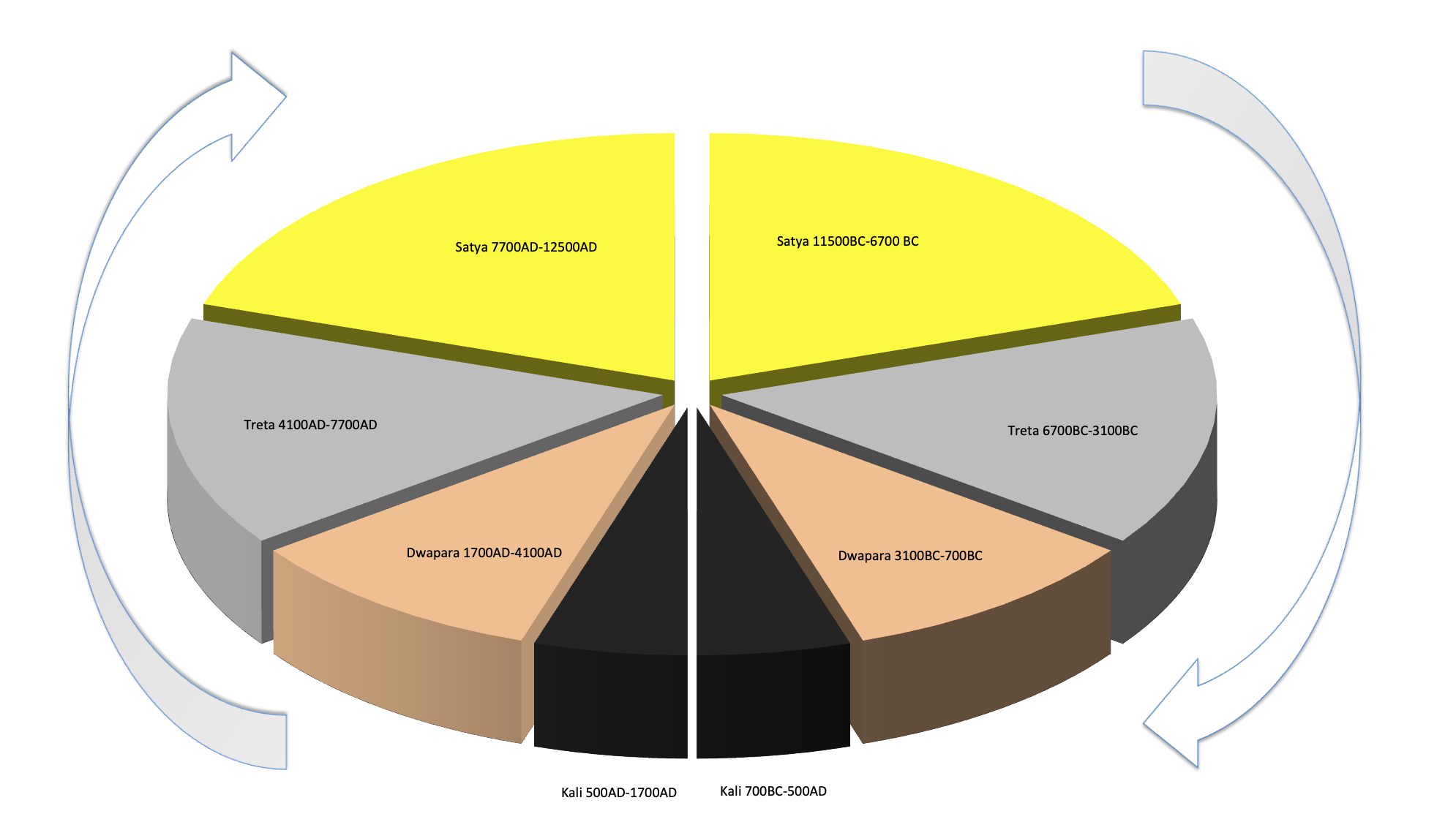
Is this a New Age of Dwapara Yuga?
The short answer is yes. Since the year 1900, we have seen tremendous advances in technology improving our physical lives, from penicillin, to refrigeration, cars, planes, computer networks, and smartphones. We have also seen a growth in personal freedoms, from the ability to vote, access to medicine, schooling, career choices, buying homes, and global travel.
This period has also led to expanded interest in the realms of psychology, spirituality, and self-improvement generally, as more and more people meet and exceed their external needs and begin to look to their inner needs.
Yuga or Great Year
A longer answer is that although everyone knows the cycles of day to night, phases of the moon, and passage of days in a year (and Zodiac signs), there is another and much longer rising and falling cycle that is much less well known.
It was familiar to the ancients and explains our present age. The ancient Indian Vedic civilization called it the “Yuga” and the later ancient Greeks called it the “The Great Year.” Rather than being a 24-hour day, approx. 30-day lunar cycle, or approx. 365-day calendar year, it spans 24,000 years.
In 1894, Swami Sri Yukteswar, a well-known yogi, popularized the idea drawn from ancient Vedic texts (and the subject of many worldwide stories from demigods to the deluge) of a cycle that raises consciousness gradually over 12,000 years and then lowers it over the following 12,000 years.
By his astronomical calculations, we entered an age of understanding of energy and expansion in consciousness called “Ascending Dwapara Yuga” from 1900 AD.
Dwapara Yuga or Bronze Age
The Greeks and many other ancient cultures shared this idea of a “Great Year,” with the ages of man, ascending from an “Iron Age,” to a “Bronze Age,” “Silver Age,” to a “Golden Age,” before falling in reverse order. The chart below details those ascending ages, their durations, and main characteristics.
Ages with Vedic / Greek name
Kali Yuga / Iron Age
Dwapara (Dvapara) Yuga / Bronze Age
Treta Yuga / Silver Age
Satya Yuga / Golden Age
Length
1,200 years
2,400 years
3,600 years
4,800 years
Characteristic
Materialism and ignorance
Space-annihilators
Time-annihilators
Harmony with divine plan
The ages do not abruptly transition from one to another but gradually transition like everything else in nature. For example, our present age of Dwapara Yuga began in 1700 AD and we fully entered it in 1900, with a 200-year period of transition.
Since we are only just entering the Dwapara Yuga, what we see in society are conflicts such as the Civil War (1862), WWI (1914), WWII (1939), the Cold War (1945), and even the war in Ukraine (2022) that are gradually lessening the grip of Kali Yuga institutions and ushering in a full expression of Dwapara Yuga.
In the US, we can see this most clearly in a changing society striving to embrace individuals without regard to race, color, religion, sex, national origin, age, disability, or genetic information rather than treating people just as undifferentiated members of large collectives.
Books
If you would like to know more, there are some excellent books here.
This period has also led to expanded interest in the realms of psychology, spirituality, and self-improvement generally, as more and more people meet and exceed their external needs and begin to look to their inner needs.
Yuga or Great Year
A longer answer is that although everyone knows the cycles of day to night, phases of the moon, and passage of days in a year (and Zodiac signs), there is another and much longer rising and falling cycle that is much less well known.
It was familiar to the ancients and explains our present age. The ancient Indian Vedic civilization called it the “Yuga” and the later ancient Greeks called it the “The Great Year.” Rather than being a 24-hour day, approx. 30-day lunar cycle, or approx. 365-day calendar year, it spans 24,000 years.
In 1894, Swami Sri Yukteswar, a well-known yogi, popularized the idea drawn from ancient Vedic texts (and the subject of many worldwide stories from demigods to the deluge) of a cycle that raises consciousness gradually over 12,000 years and then lowers it over the following 12,000 years.
By his astronomical calculations, we entered an age of understanding of energy and expansion in consciousness called “Ascending Dwapara Yuga” from 1900 AD.
Dwapara Yuga or Bronze Age
The Greeks and many other ancient cultures shared this idea of a “Great Year,” with the ages of man, ascending from an “Iron Age,” to a “Bronze Age,” “Silver Age,” to a “Golden Age,” before falling in reverse order. The chart below details those ascending ages, their durations, and main characteristics.
Ages with Vedic / Greek name
Kali Yuga / Iron Age
Dwapara (Dvapara) Yuga / Bronze Age
Treta Yuga / Silver Age
Satya Yuga / Golden Age
Length
1,200 years
2,400 years
3,600 years
4,800 years
Characteristic
Materialism and ignorance
Space-annihilators
Time-annihilators
Harmony with divine plan
The ages do not abruptly transition from one to another but gradually transition like everything else in nature. For example, our present age of Dwapara Yuga began in 1700 AD and we fully entered it in 1900, with a 200-year period of transition.
Since we are only just entering the Dwapara Yuga, what we see in society are conflicts such as the Civil War (1862), WWI (1914), WWII (1939), the Cold War (1945), and even the war in Ukraine (2022) that are gradually lessening the grip of Kali Yuga institutions and ushering in a full expression of Dwapara Yuga.
In the US, we can see this most clearly in a changing society striving to embrace individuals without regard to race, color, religion, sex, national origin, age, disability, or genetic information rather than treating people just as undifferentiated members of large collectives.
Books
If you would like to know more, there are some excellent books here.